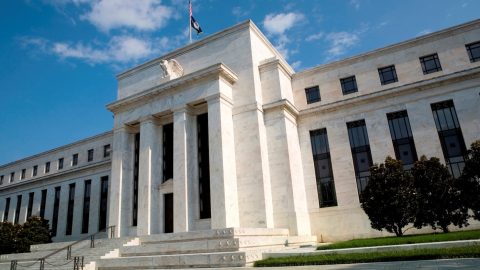The most important central bank in the world, the Federal Reserve of the USA, has announced a historic decision as a result of its FOMC meeting on 20 September: the central bank balance sheet, hugely inflated in the wake of the bond purchase programme, will be gradually reduced from October onwards. Generally speaking this is a good sign, as the decision can be seen as further testimony to the normalisation of the economic environment.
Central bank balance sheet had increased to USD 4,500bn by 2014
Prior to the Great Recession at the beginning of 2007, the central bank balance sheet totalled USD 900bn. From Q3 2008 to Q3 2014, an enormous volume of liquidity was being pumped into the market. This measure was probably how the USA and the global economy managed to avoid slipping into depression and stagflation. Since the beginning of 2015, the central bank’s balance sheet total has remained steady at a sizeable USD 4,500bn. A further expansion has not been necessary due to the economic recovery. From coming October, this volume will be subject to a gradual reduction. More specifically, in a first step, the expiring bonds and the coupon payments up to an upper limit of USD 10bn will not be reinvested anymore. The economic environment has therefore been deemed sufficiently self-supporting to absorb a gradual reduction of the central bank balance sheet.
Increase in Fed funds rate planned as next step
The bandwidth of the Fed funds rate has been left unchanged at 1%-1.25%. On the basis of the core rate for personal consumer spending of 1.4% as published for July, the real Fed funds rate is -0.28%. This is roughly in line with the real neutral interest rate of -0.22% as estimated by Fed economists. “Neutral” in this context means that it has neither a supporting nor dampening effect on the economy. The forecasts by the Fed suggest a gradual increase of inflation to 2% by 2019. This would theoretically require two and a half Fed funds rate hikes to 1.8% in order for the real Fed funds rate to remain unchanged. In fact, the Fed is even more optimistic: for the end of 2017, it still predicts 1.4% (one interest rate hike), and for the end of 2018 already 2.1% (three further hikes). This implies the assumption that the neutral interest rate will also rise a bit (from currently -0.22% to 0%).
The key facts of the central bank policy
- US economic growth becomes gradually more self-supporting and sustainable. According to the Fed forecasts, it will fall from 2.4% this year to its estimated potential growth rate of 1.8% in 2020.
- Increase of the currently low inflation towards central bank target (2%) by 2019.
- Reduction of the central bank balance sheet.
- Increase in the neutral Fed funds rate to 2.8% (long-term); neutral interest rate: 0.8%.
- Fed funds rate increases in line with the economic improvement to the long-term neutral Fed funds rate level: the extent will be determined by a) the estimated increase in inflation and b) by the implied assumption of a rise in the neutral interest rate.
This scenario is generally positive for equities and disadvantageous for credit-safe government bonds. NB. In the coming months, some Fed members’ (including Chairwoman Yellen’s) positions will be newly appointed. This could of course change the aforementioned scenario.
Legal note:
Prognoses are no reliable indicator for future performance.
Legal disclaimer
This document is an advertisement. Unless indicated otherwise, source: Erste Asset Management GmbH. The language of communication of the sales offices is German and the languages of communication of the Management Company also include English.
The prospectus for UCITS funds (including any amendments) is prepared and published in accordance with the provisions of the InvFG 2011 as amended. Information for Investors pursuant to § 21 AIFMG is prepared for the alternative investment funds (AIF) administered by Erste Asset Management GmbH pursuant to the provisions of the AIFMG in conjunction with the InvFG 2011.
The currently valid versions of the prospectus, the Information for Investors pursuant to § 21 AIFMG, and the key information document can be found on the website www.erste-am.com under “Mandatory publications” and can be obtained free of charge by interested investors at the offices of the Management Company and at the offices of the depositary bank. The exact date of the most recent publication of the prospectus, the languages in which the fund prospectus or the Information for Investors pursuant to Art 21 AIFMG and the key information document are available, and any other locations where the documents can be obtained are indicated on the website www.erste-am.com. A summary of the investor rights is available in German and English on the website www.erste-am.com/investor-rights and can also be obtained from the Management Company.
The Management Company can decide to suspend the provisions it has taken for the sale of unit certificates in other countries in accordance with the regulatory requirements.
Note: You are about to purchase a product that may be difficult to understand. We recommend that you read the indicated fund documents before making an investment decision. In addition to the locations listed above, you can obtain these documents free of charge at the offices of the referring Sparkassen bank and the offices of Erste Bank der oesterreichischen Sparkassen AG. You can also access these documents electronically at www.erste-am.com.
Our analyses and conclusions are general in nature and do not take into account the individual characteristics of our investors in terms of earnings, taxation, experience and knowledge, investment objective, financial position, capacity for loss, and risk tolerance. Past performance is not a reliable indicator of the future performance of a fund.
Please note: Investments in securities entail risks in addition to the opportunities presented here. The value of units and their earnings can rise and fall. Changes in exchange rates can also have a positive or negative effect on the value of an investment. For this reason, you may receive less than your originally invested amount when you redeem your units. Persons who are interested in purchasing units in investment funds are advised to read the current fund prospectus(es) and the Information for Investors pursuant to § 21 AIFMG, especially the risk notices they contain, before making an investment decision. If the fund currency is different than the investor’s home currency, changes in the relevant exchange rate can positively or negatively influence the value of the investment and the amount of the costs associated with the fund in the home currency.
We are not permitted to directly or indirectly offer, sell, transfer, or deliver this financial product to natural or legal persons whose place of residence or domicile is located in a country where this is legally prohibited. In this case, we may not provide any product information, either.
Please consult the corresponding information in the fund prospectus and the Information for Investors pursuant to § 21 AIFMG for restrictions on the sale of the fund to American or Russian citizens.
It is expressly noted that this communication does not provide any investment recommendations, but only expresses our current market assessment. Thus, this communication is not a substitute for investment advice.
This document does not represent a sales activity of the Management Company and therefore may not be construed as an offer for the purchase or sale of financial or investment instruments.
Erste Asset Management GmbH is affiliated with the Erste Bank and austrian Sparkassen banks.
Please also read the “Information about us and our securities services” published by your bank.


